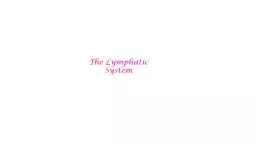

1 Transport fluids excess interstitial fluids are returned to the cardiovascular system 2 Immunity houses and transports lymphocytes 3 Transport lipids circulates fats like vitamins ID: 912106
Download Presentation The PPT/PDF document "The Lymphatic System Functions" is the property of its rightful owner. Permission is granted to download and print the materials on this web site for personal, non-commercial use only, and to display it on your personal computer provided you do not modify the materials and that you retain all copyright notices contained in the materials. By downloading content from our website, you accept the terms of this agreement.
Slide1
The Lymphatic System
Slide2Functions
1. Transport fluids = excess
interstitial fluids are returned to the cardiovascular system2. Immunity = houses and transports lymphocytes3. Transport lipids = circulates fats, like vitamins D,E,A,K, that were absorbed by GI tract
Image courtesy of
www.lepra.org
Lymphatic
filariasis
Slide3Anatomy
1.
Lymph (the fluid)2. Vessels (the tubes)3. Cells (WBC’s for immunity)4. Tissues (
nonencapsulated small clusters of lymphatics)5.
Organs (
encapsulated lymphatic structures)Note: the lymphatic system has
no pump to circulate thefluids, movement of fluid is passive and similar to venousblood return to the heart.
Slide4Lymph
Fluid in
circulatory system is plasmawhen it leaves capillaries it becomes interstitial fluidwhen it enters the lymphatic capillary it becomes lymph Usually its clear, except in intestines where it is white (lacteals) and cloudy because of freshly absorbed fats
(lymph here is called chyle)
Slide5Vessels
Capillaries
(20.1)
↓
Endothelium,
1
-way mini
Valves,
Anchoring
Filaments,
Blind ends,
Called
lacteals
near intestine,
None
in bone or CNS
Collecting
Vessels
↓3 tunicas(like veins)Travel with arteries & veinsNodes periodically
Trunks↓Drain regionsFive:R & L LumbarR & L JugularR & L Bronco-MediastinalR & L SubclavianIntestinal (unpaired)
Ducts↓Join CV systemat junctionof Jugularand SubclavianVeinsTwo:R. LymphaticThoracic
Slide6Slide7Cells
Lymphocytes
= T & B cells for specific immunityMacrophages (monocytes) = phagocytosis and antigen presentationDendritic cells =
phagocytosis and antigen presentationReticular cells = make the
stroma
of the lymph tissue and support the WBC’s
Slide8Immunity
Slide9Innate - Nonspecific Defenses
First Line of Defense = Surface Barriers Forms physical & chemical barriersA. SkinMany layers
, tight junctionsWhen intact it forms an excellent barrier
B. Mucous membranes
When intact does form a barrier
MucusCilia
Slide10First Line of Defense (cont.)
C
. Other barriersLacriminal fluids = tears wash the surface of the eyesSaliva = washes the mouth/teethSebum = makes protective film over surface & has chemical that inhibits microbial growthAcidity (skin, vagina, stomach) inhibits
microbial growth
Slide11Nonspecific Defenses (cont.)
Second Line of Defense
Cells Phagocytes Non-phagocytesB. InflammationC. Antimicrobial Proteins Complement InterferonD. Fever
Slide12Specific Defenses (Immunity)
A specific immune response is
provoked when microbes colonizeInvolves a coordinated attack by B and T lymphocytes Results in Memory cells Two branches
Humoral (Antibody-Mediated) = involves the production of
antibodies
by B cells (particularly good for microbes in body fluids
) 2. Cellular (Cell-Mediated) = involves T cells directly attacking the microbe (particularly good for microbes hiding inside cells)
Slide13Two Classes of MHC proteins:
MHC I
are found on all body cells except RBC’sB & T cells do not respond to these proteins when they are “normal”Infected body cells/cancerous cells have abnormal MHC I proteins and will provoke a reaction
MHC II are found on various immune cells
Usually will include pieces of the
microbeUsed to present the antigen to other immune
cells
Slide14Humoral Immunity – antibody mediated
Involves
B-Lymphocytes making antibodiesB-cells have receptors (BCR) that allow them to recognize “non-self”They can bind directly to antigenThey can process antigen and display it to other immune cells on an
MHCII
Slide15Humoral/Antibody-Mediated Immunity (cont.)
Clonal Selection
The immune response begins when the B-cell receptors (BCR) binds to specific antigen
Slide16Humoral/Antibody-Mediated Immunity (cont.)
Once activated by
binding
B-Cells clone
Most
Enlarge and become
plasma cells
Plasma
cells
secrete
antibodies
Into body fluids
Antibodies
bind
to antigen
Some become
Memory
B-cells
Slide17Humoral Immunity (cont.)
Plasma
cells secrete antibodiesinto body fluidsAntibodies circulate and bind toantigen
Microbe
with antigen
Antibody
Slide18Humoral/Antibody-Mediated Immunity (cont.)
Slide19Cell-Mediated Immunity
Involves the T-Lymphocytes directly attacking the antigensTwo major T-cell populations: Classification by cell membrane co-receptors:CD4 cells = Helper T cells (TH
)CD8 cells = Cytotoxic cells (T
C
)
Slide20Cell-Mediated Immunity (cont.)
T
-Lymphocytes can not bind directly to free antigensAntigen must be “presented” to T-cells bound to an MHC
Infected body cells present antigen on
MHCI
Slide21Cell-Mediated Immunity (cont.)
Other immune cells
(
macrophages, B-cells,
Dendritic cells
)
present antigen on MHCII
Slide22Cell-Mediated Immunity (cont.)
The immune response begins when the
T-cell receptors (TCR) binds to the antigen (specificity)TCR/CD8 receptors on TC bind to abnormal MHC I presenting antigen
TCR/CD4 receptors on TH
bind
MHC II presenting antigen
BODY CELL
IMMUNE CELL
Slide23Cell-Mediated Immunity (cont.)
Activation requires costimulation
After the initial binding B7 proteins (made when innate immune system is stimulated) on the APC bind to CD28 receptors on the T cellsAfter binding occurs chemical stimulation is required for the immune reaction to proceed
CD8
MHCI
CD4
MHCII
Slide24Cell-Mediated Immunity (cont.)
Once activated by
binding and costimulation, the T-lymphocyte rapidly divides to create an army of clones to fight the specific antigen
CD4
CD8
Slide25Cell-Mediated Immunity (cont.)
Activated, Cloned Helper-
T Cells (CD4) release chemicals that:Stimulate Cytotoxic T cellsStimulate B cellsEnhance activity of macrophages and NK’s
Slide26Cell-Mediated Immunity (cont.)
Activated, cloned
Cytotoxic T- Lymphocytesdirectly attack microbe with the specific antigenPerforins = make holes in membranesGranzymes = destroy proteins
Slide27Cell-Mediated Immunity (cont.)
Memory
T-Lymphocytes will attack the microbe more quickly next time it enters
Slide28Slide29The Digestive System
Slide30Slide31Digestive
Processes
(fig.23.2)